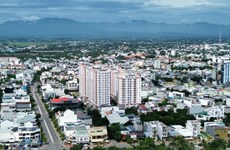Mekong Delta to increase transport capacity of waterborne freight
The Mekong Delta should increase its waterborne freight transport
capacity to 83 million tonnes by 2020, up 72 percent from the current
volume, according to the Ministry of Transport’s plan.
The Mekong Delta should increase its waterborne freight transport
capacity to 83 million tonnes by 2020, up 72 percent from the current
volume, according to the Ministry of Transport’s plan.
With a coastline of 700 kilometres and 28,000 kilometres of criss-crossed canals, accounting for 70 percent of inland waterways nationwide, the delta boasts great potential to develop its marine transport.
The ministry’s plan aims to develop a system of seaports in the region which are capable of accommodating heavily-loaded containers.
In the foreseeable future, the Can Tho port will be expanded to carry 650,000 tonnes of goods per year and receive 10,000-tonne ships.
The second phase of the Cai Cui port in Can Tho city will be carried out with the construction of four wharves able to accommodate 10,000-20,000 tonne ships and handle a maximum of 2.5 million tonnes of goods annually.
A 34km canal connecting the port to the sea is under construction, and once completed, the project is expected to help reduce transport costs and ease overloading at the waterway and land sections connecting the delta with Ho Chi Minh City .
The plan also envisions the upgrading of several sections of domestic waterways, including corridors from Ho Chi Minh City to Kien Giang and Ca Mau provinces, as well as building freight and passenger ports.
Can Tho city in particular is building an international waterway on the Hau River, upgrading the Can Tho and Tra Noc ports, and building cargo wharves to serve 7,500-tonne ships at Tra Noc port.
To promote economic growth in Ben Tre, Tien Giang, Dong Thap and Vinh Long provinces, routes will be opened on Tien River for sea vessels with loading capacities of 7,000-8,000 tonnes to pass, while waterway routes connecting Ho Chi Minh City with ports in the Mekong Delta as well as sea ports will be upgraded, according to the plan.-VNA
With a coastline of 700 kilometres and 28,000 kilometres of criss-crossed canals, accounting for 70 percent of inland waterways nationwide, the delta boasts great potential to develop its marine transport.
The ministry’s plan aims to develop a system of seaports in the region which are capable of accommodating heavily-loaded containers.
In the foreseeable future, the Can Tho port will be expanded to carry 650,000 tonnes of goods per year and receive 10,000-tonne ships.
The second phase of the Cai Cui port in Can Tho city will be carried out with the construction of four wharves able to accommodate 10,000-20,000 tonne ships and handle a maximum of 2.5 million tonnes of goods annually.
A 34km canal connecting the port to the sea is under construction, and once completed, the project is expected to help reduce transport costs and ease overloading at the waterway and land sections connecting the delta with Ho Chi Minh City .
The plan also envisions the upgrading of several sections of domestic waterways, including corridors from Ho Chi Minh City to Kien Giang and Ca Mau provinces, as well as building freight and passenger ports.
Can Tho city in particular is building an international waterway on the Hau River, upgrading the Can Tho and Tra Noc ports, and building cargo wharves to serve 7,500-tonne ships at Tra Noc port.
To promote economic growth in Ben Tre, Tien Giang, Dong Thap and Vinh Long provinces, routes will be opened on Tien River for sea vessels with loading capacities of 7,000-8,000 tonnes to pass, while waterway routes connecting Ho Chi Minh City with ports in the Mekong Delta as well as sea ports will be upgraded, according to the plan.-VNA













